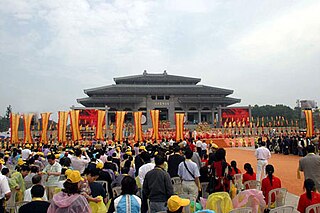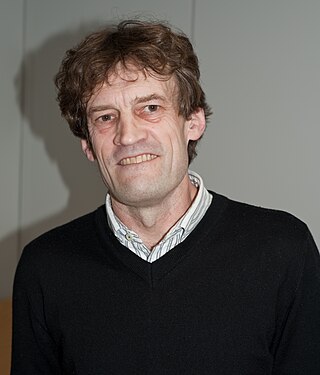Related Research Articles

Nichiren Buddhism, also known as Hokkeshū, is a branch of Mahayana Buddhism based on the teachings of the 13th-century Japanese Buddhist priest Nichiren (1222–1282) and is one of the Kamakura period schools. Its teachings derive from some 300–400 extant letters and treatises either authored by or attributed to Nichiren.

Shinto is a religion originating in Japan. Classified as an East Asian religion by scholars of religion, its practitioners often regard it as Japan's indigenous religion and as a nature religion. Scholars sometimes call its practitioners Shintoists, although adherents rarely use that term themselves. There is no central authority in control of Shinto, with much diversity of belief and practice evident among practitioners.

Religion in Japan is manifested primarily in Shinto and in Buddhism, the two main faiths, which Japanese people often practice simultaneously. According to estimates, as many as 80% of the populace follow Shinto rituals to some degree, worshiping ancestors and spirits at domestic altars and public shrines. An almost equally high number is reported as Buddhist. Syncretic combinations of both, known generally as shinbutsu-shūgō, are common; they represented Japan's dominant religion before the rise of State Shinto in the 19th century.

Buddhism was first established in Japan in the 6th century CE. Most of the Japanese Buddhists belong to new schools of Buddhism which were established in the Kamakura period (1185-1333). During the Edo (Tokugawa)-period (1603–1868), Buddhism was controlled by the feudal Shogunate. The Meiji-period (1868–1912) saw a strong response against Buddhism, with persecution and a forced separation between Buddhism and Shinto.

With nearly 250,000 Buddhists, Brazil is home to the third-largest Buddhist population in the Americas, after the United States and Canada. Buddhism in Brazil consists of practitioners from various Buddhist traditions and schools. A number of Buddhist organisations and groups are also active in Brazil, with nearly 150 temples spread across the states.
John Weil Nathan is an American translator, writer, scholar, filmmaker, and Japanologist. His translations from Japanese into English include the works of Yukio Mishima, Kenzaburō Ōe, Kōbō Abe, and Natsume Sōseki. Nathan is also an Emmy Award-winning producer, writer and director of many films about Japanese culture and society and American business. He is Professor Emeritus of Japanese Cultural Studies at the University of California, Santa Barbara.

The Japanese term shinbutsu bunri (神仏分離) indicates the separation of Shinto from Buddhism, introduced after the Meiji Restoration which separated Shinto kami from buddhas, and also Buddhist temples from Shinto shrines, which were originally amalgamated. It is a yojijukugo phrase.

The Twenty-Two Shrines of Japan is one ranking system for Shinto shrines. The system was established during the Heian period and formed part of the government's systematization of Shinto during the emergence of a general anti-Chinese sentiment and the suppression of the Taoist religion. It involved the establishment of the shrines as important centers of public life in Japan. It played a role in official imperial ceremonies such as the Practice of Chinkon. An extensive body of literature also emerged containing information about each shrine, including the shrine's origin, priestly dress, divine treatises, the system of shrine removal, subordinate shrines, and annual cycle of rituals, among others.

State Shintō was Imperial Japan's ideological use of the Japanese folk religion and traditions of Shinto. The state exercised control of shrine finances and training regimes for priests to strongly encourage Shinto practices that emphasized the Emperor as a divine being.
The University of Chicago Divinity School is a private graduate institution at the University of Chicago dedicated to the training of academics and clergy across religious boundaries. Formed under Baptist auspices, the school today lacks any sectarian affiliations.

Buddhism's rich history spans over 2,500 years, originating from the Indian subcontinent in the 2nd century AD. Teachings of the Buddha were introduced over time, as a response to brahmanical teachings. Buddhism relies on the continual analysis of the self, rather than being defined by a ritualistic system, or singular set of beliefs. The intersections of Buddhism with other Eastern religions, such as Taoism, Shinto, Hinduism, and Bon illustrate the interconnected ideologies that interplay along the path of enlightenment. Buddhism and eastern religions tend to share the world-view that all sentient beings are subject to a cycle of rebirth that has no clear end.

In the study of comparative religion, the East Asian religions or Taoic religions, form a subset of the Eastern religions. This group includes Chinese religion overall, which further includes ancestor veneration, Chinese folk religion, Confucianism, Taoism and popular salvationist organisations, as well as elements drawn from Mahayana Buddhism that form the core of Chinese and East Asian Buddhism at large. The group also includes Japanese Shinto, Tenrikyo, and Korean Muism, all of which combine Shamanistic elements and indigenous ancestral worship with various influences from Chinese religions. Chinese salvationist religions have influenced the rise of Japanese new religions such Tenriism and Korean Jeungsanism; as these new religious movements draw upon indigenous traditions but are heavily influenced by Chinese philosophy and theology. All these religious traditions generally share core concepts of spirituality, divinity and world order, including Tao ('way') and Tian ('heaven').

Haibutsu kishaku (廃仏毀釈) is a term that indicates a current of thought continuous in Japan's history which advocates the expulsion of Buddhism from Japan. More narrowly, it also indicates a particular historic movement and specific historic events based on that ideology which, during the Meiji Restoration, produced the destruction of Buddhist temples, images and texts, and the forced return to secular life of Buddhist monks. It is a yojijukugo phrase.
Bernhard Scheid is an Austrian historian, academic, and Japanologist, affiliated to the Austrian Academy of Sciences and the Institute of East Asian Studies at the University of Vienna. In addition, Scheid counts among the Austrian top players of the game of Go.
Helen Hardacre is an American Japanologist. She is the Reischauer Institute Professor of Japanese Religions and Society at the Department of East Asian Languages and Civilization, Harvard University.

John Lawrence Breen is a British academic and Japanologist. He is a specialist in Japanese history at the International Research Center for Japanese Studies in Kyoto. He writes in English and Japanese on the history of Shinto and the imperial institution.
Fabio Rambelli is an Italian academic, author and editor. He is a professor in the Department of Religious Studies at the University of California, Santa Barbara (UCSB).
William Marvin Bodiford is an American professor and author. He teaches Buddhist Studies and religion in the cultures of Japan and East Asia at the University of California, Los Angeles.

The predominant religions in Northeast China are Chinese folk religions led by local shamans. Taoism and Chinese Buddhism were never well established in this region of recent Han Chinese settlement. For this reason the region has been a hotbed for folk religious and Confucian churches, which provide a structure, clergy, scriptures and ritual to the local communities. The Way of the Return to the One, the Universal Church of the Way and its Virtue (Shanrendao), and more recently the Falun Gong, have been the most successful sects in Manchuria, claiming millions of followers. Schools of Tibetan Buddhism, traditionally transmitted by the region's Mongol minorities, have made inroads also among Han Chinese.
Mayfair Yang or Yang Meihui is a Taiwanese-American cultural anthropologist of China. Her research focuses on modernity, religion and secularism, state formation, religious environmentalism, China Studies, gender studies, postcolonial studies, and media studies.
References
- ↑ Library of Congress authority file, Grapard, Allan G., n92-45883
- 1 2 University of California, Santa Barbara (UCSB), Emeritus of East Asian Languages and Cultural Studies (EALCS): faculty bio Archived 2011-07-20 at the Wayback Machine
- ↑ UCSB, Religious Studies Department of Religions, History of the Department Archived 2011-07-22 at the Wayback Machine
- 1 2 3 4 Higashibaba, Ikuo. "Historiographical Issues in the Studies of Japanese Religion: Buddhism and Shinto in Premodern Japan," Pacific World, New Series, No. 10, 1994, pp. 141-142.
- ↑ WorldCat Identities Archived 2010-12-30 at the Wayback Machine : Grapard, Allan G.